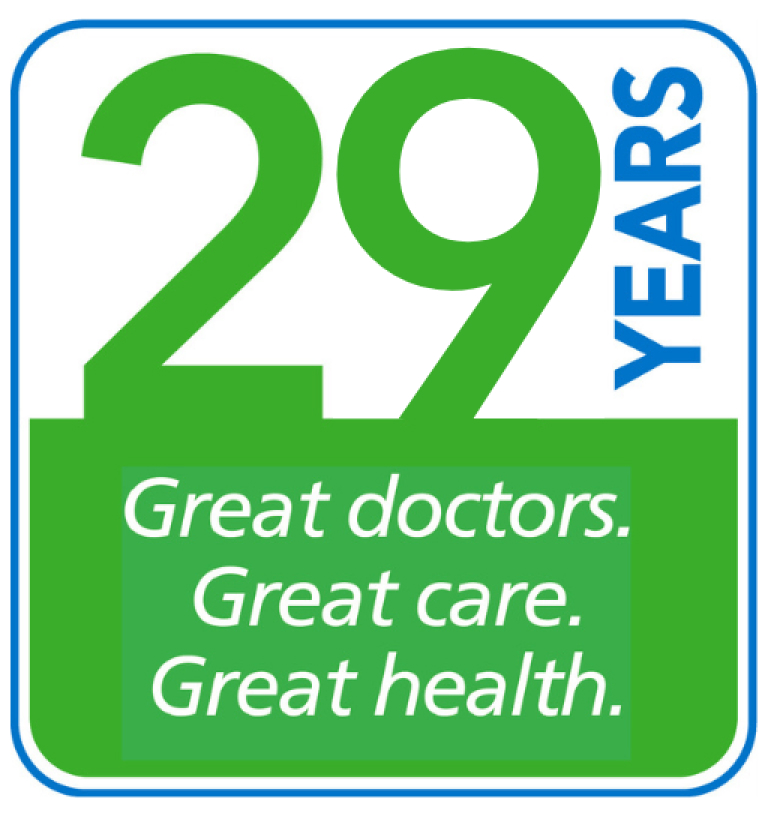Category Archives: Health & Wellness
Summer Health Tips
Because we care about your health and safety, Maryland Primary Care Physicians has put together this list of tips to help your family enjoy a healthy and safe summer.

Tip #1: Beware of the Sun
Studies show that more than a million cases of skin cancer are diagnosed each year, and that even a few serious sunburns can increase your risk of getting skin cancer. You can protect yourself during the time of day when the sun’s UV (ultraviolet) rays are strongest — between 10:00 a.m. and 4:00 p.m. — by wearing long sleeves and pants, and by applying sunscreen with UVA & UVB protection and an SPF of 30 or higher. The American Cancer Society recommends that children wear a waterproof sunscreen with an SPF of 30 or higher and that it be reapplied every 2 hours when at the pool or beach where the sunscreen may wear off quickly.
Tip #2: Prevent Heat-related Illness

Normally, the body has ways of keeping itself cool, by letting heat escape through the skin, and by evaporating sweat (perspiration). If the body does not cool properly, or does not cool enough, a person may suffer a heat-related illness. Anyone can be susceptible although the very young and very old are at greater risk. Heat-related illnesses can become serious or even deadly if unattended.
- Dress for the heat. Wear lightweight, light-colored clothing. It is also a good idea to wear hats or to use an umbrella.
- Drink water. Carry water or juice with you and drink continuously even if you do not feel thirsty. Avoid alcohol and caffeine, which dehydrate the body.
- Eat small meals and eat more often. Avoid foods that are high in protein which increase metabolic heat.
- Slow down. Avoid strenuous activity. If you must do strenuous activity, do it during the coolest part of the day, either early morning or late evening.
- Take regular breaks when engaged in physical activity on warm days. Remember, have fun, but stay cool!
Tip #3: Lawn Mower Safety
Warm weather means there’s lots of lawn mowing to be done! Always take the following precautions to guard against injury:
- Try to use a mower with a safety control that stops the mower if the handle is let go.
- Wear sturdy shoes (not sandals or sneakers) while mowing.
- Prevent injuries from flying objects, such as stones or toys, by picking up objects from the lawn before mowing begins. Have anyone who uses a mower wear hearing and eye protection.
- Children younger than 16 years should not be allowed to use ride-on mowers. Children younger than 12 years should not use walk-behind mowers.

Tip #4: Bike Safety
While bike riding is a staple of summer for many, it can lead to severe injury for those who aren’t careful. Some rules for bike safety are:
- Always wear a bicycle helmet. The most serious bike injuries are a result of head injury.
- Follow all traffic rules (bikes have to follow the same traffic rules and signs as cars), wear bright colors or clothes that reflect light at night so drivers can see you.
- Also, get a headlight for the front of your bike and reflectors on the front and back of your bike if you ride at night. Wearing a helmet also applies for activities such as skateboarding or rollerblading.
Tip #5: Outdoor Food Safety
 No matter what time of the year, more and more people are cooking outdoors. But outdoor barbeques and picnics during the summer pose a few extra challenges. Protect yourself and your friends and family in these ways:
No matter what time of the year, more and more people are cooking outdoors. But outdoor barbeques and picnics during the summer pose a few extra challenges. Protect yourself and your friends and family in these ways:
- Keep perishable food cool on longer trips; place it in a cooler with ice or freezer packs. Put raw meat/poultry in a plastic bag so juices won’t cross-contaminate your fruits or vegetables.
- Don’t keep food out in the heat; perishable food sitting outside for more than 2 hours is not safe.
- To prevent food borne illness, don’t use the same utensils or platters for raw and cooked meats, and be sure to keep food surfaces clean.
Tip #6: Keep a First Aid Kit with you in your Home, Car and Boat
Stay safe this summer. Make sure to have first aid supplies on hand at home, in your car and when you travel. Here is a list of the key items to include in a family first aid kit from the American Red Cross.
Click here for a printable version of the Summer Health Tips.
Understanding Pre-Diabetes: A Chance to Change Your Future
Type 2 diabetes is a serious health problem in the U.S. Previously referred to as “adult-onset” diabetes, this condition is being diagnosed more and more in children. Unfortunately, the rise in diabetes relates directly to the rise in obesity rates. Long-term complications associated with diabetes can include heart and blood vessel disease, kidney problems, and vision impairment or loss, among others.
The good news is that doctors are working closely with patients to diagnose early signs of the disease, when it is still considered “Pre-Diabetes.”
“We want patients to understand that there are risk factors for developing diabetes that are in our control, such as weight and physical activity. If we can intervene before someone develops full-fledged diabetes, we’ve saved them a life-long struggle with a complicated disease,” says Dr. Loraine Dailey, of MPCP Pasadena.
What is Pre-Diabetes?
Diabetes is a disorder of the endocrine system in which blood sugar levels in the body consistently stay above a normal range. There are two classifications of the disease: Type 1, which affects 5-10 % of people and is unpreventable, and Type 2, found in 90% of diabetics, and which can often be prevented or sometimes reversed.
Pre-diabetes is the condition where your blood glucose levels are higher than normal, but not high enough to be diagnosed as Type 2 diabetes. There are often no symptoms and it’s expected that nearly 75 million people in the U.S. over age 20 have pre-diabetes. While not all people who have this condition will develop full Type 2 diabetes, research shows that the majority will within 10 years.
Are You at Risk?
As with many diseases, there are some risk factors for pre-diabetes that are beyond our control, but several that we can control or influence.
Uncontrollable risk factors include: Age (most common after age 50), Race (higher rates among African Americans, Latinos and Native Americans), and Family history of Type 2 diabetes. Some women can develop diabetes during pregnancy (gestational diabetes), which can lead to complications, but usually regresses after delivery.
Now on to the risk factors that we can control: Primarily, being overweight or obese (especially around the abdomen- “belly fat”), Having high cholesterol, and an Inactive/Sedentary lifestyle.
“We know that obesity and being sedentary contribute greatly to a person’s risk of developing pre-diabetes,” says Monica Erceg, a CRNP at the MPCP Pasadena office. “When patients change these risk factors, they can often prevent pre-diabetes. And, notably, if they already have diabetes they can reduce the levels of insulin they need to take– or even reverse some of the serious side-effects of the disease.”
How is Pre-diabetes Diagnosed?
If you are over age 45, you should have a fasting blood glucose test to determine your risk for pre-diabetes. Your doctor will likely suggest this as part of a regular physical. He or she may choose to perform an oral glucose tolerance test (OGTT) or hemoglobin A1C (average blood sugar) test first.
However, you should be tested earlier if you are overweight (with a BMI -Body Mass Index-of 25 or over) and have any of the following risk factors/symptoms:
- Close relatives with diabetes
- Physically inactive
- Belong to high-risk ethnic group
- Have high triglycerides or low HDL (good cholesterol)
- Have had abnormal blood sugar tests in the past
- Have a history of heart disease
- Have previously had gestational diabetes
- Experience symptoms of increased thirst, frequent urination, blurred vision, extreme fatigue, or darkened skin areas, often around the neck, armpits, elbows or knees
The Good News: Reducing Risk
Depending on the results of your blood glucose test and risk profile, you and your doctor can come up with a plan to intervene and either reduce your chances of developing pre-diabetes, or start treating it before it progresses.
“With the emphasis on preventing pre-diabetes, we’re often testing patients earlier since there are rarely clear symptoms in the majority of cases,” says Dr. Dailey. “This gives us the opportunity to identify lifestyle changes, or treatment options, that are proven to reduce the risk of this disease.”
Make sure to discuss pre-diabetes with your primary care provider. It may give you the chance for a healthier future.
Doctor’s Advice: 10 Tips for Spring Allergy Symptoms
Has the sneezing started at your house? If so you, or your family members, are likely among the thousands of allergy sufferers who have to deal with the high pollen count in Maryland each spring. In fact, experts are predicting a record high pollen count this year. Trees are the first culprit, releasing pollen as they bud in early spring. Then grasses and weeds take over in late spring and early summer. Individuals who are allergic to pollen and mold spores will have symptoms ranging from headaches to watery, itchy eyes, to sneezing, to a sore throat.
However, there are several effective treatments for dealing with allergies. Avoiding triggers – or exposure to allergens – whenever possible is the first step. But we also have effective over the counter and prescription medications. Some people respond well to allergy shots. Here are my top 10 tips to help you deal with spring allergy symptoms:
- Limit outdoor time when pollen counts are high- usually in the morning and on windy days. You can find the pollen counts for your area at http://www.webmd.com/allergies/healthtool-pollen-counter-calculator
- Spring cleaning – Make sure to clean windows, screens, air conditioning vents and other surfaces that collect dust and pollen.
- Take over the counter or prescription medications as directed by your doctor. You usually want to take medications at least 30 minutes prior to outdoor activities. Understand the difference between anti-histamines and decongestants and when to take each.
- Keep pollen out- Shut windows at home and in your car. Take off shoes at the door.
- Shower and wash hair before bed to remove any pollen that collected during the day.
- Keep pets off furniture and out of bedrooms as pollen can cling to their fur.
- Dry clothes in the dryer, not hanging outside.
- When gardening or mowing the lawn, wear a filter mask.
- Consider using a High Efficiency Particulate Air (HEPA) filter at home.
- Talk to your doctor about treatment options if your symptoms persist. Medications and allergy shots are very effective for many people once the allergen is identified.
The Changing Healthcare Environment
A Q&A with Medical Director, Dr. Jerry Levine
Q: Dr. Levine, what are your impressions of the current healthcare environment, and its impact on you as a primary care physician?
A: Today’s healthcare environment requires doctors not only to provide good care, but also measure and document good outcomes using electronic record keeping. The challenge is to do this while maintaining the one on one individual patient focus that has always been fundamental to our care.
At MPCP, we are continuing to develop effective practices to deal with these changes, as we remain focused on our patients’ well- being. The role of primary care providers is now more important than ever. Family practitioners and internal medicine specialists are on the forefront in the areas of disease prevention and wellness. We want to be partners in keeping our patients healthy, and as the population ages, this partnership will be even more critical.
Q: How do you think MPCP is positioned to deal with these changes, while continuing to provide quality care?
A: We are well prepared in many ways:
- Almost 10 years ago, we began with EMR (electronic medical records) to document patient care and outcomes;
- We recognize and have responded to patients’ need for more convenient access to care, including early morning, evening, and Saturday hours at most practices;
- We’ve adopted electronic transmission of prescriptions to pharmacies which is proven to reduce errors; and,
- We have established a strong physician recruitment program to maintain an excellent team of primary care doctors in the MPCP network.
Q: What one piece of advice would you give to patients about staying as healthy as possible?
A: We all live busy lives, but the best thing we can do to stay healthy is to make priorities of sleep, eating a healthy diet, and regular exercise (150 minutes/week). These are by far the most important things we can do, in addition to regular follow-ups and preventive care with your doctor. Another preventive measure is staying current on health screenings and adult vaccinations.



